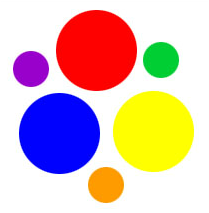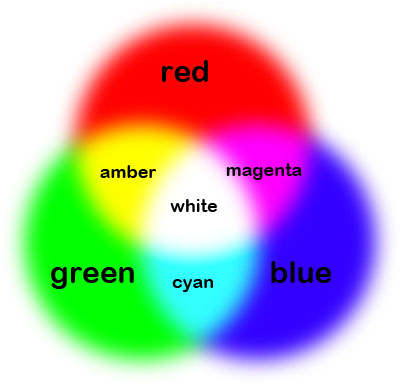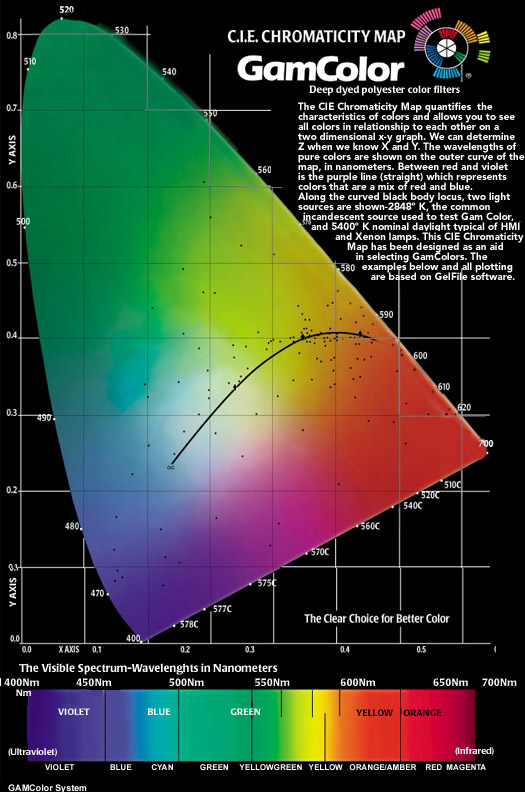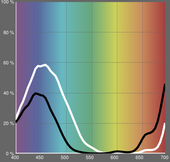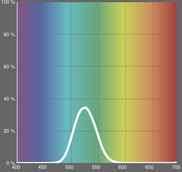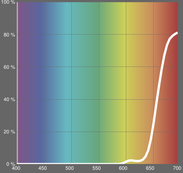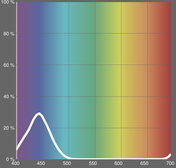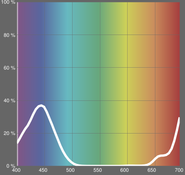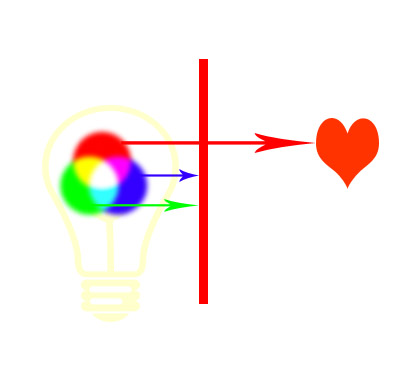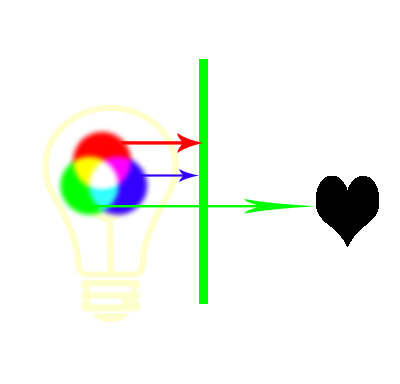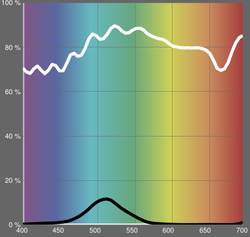Color Theory |
Color is perhaps the most significant defining factor in most lighting designs. The subtle balancing of different blues, the use of stark saturated color, or the choice to use no color at all always helps to create the world of the play in a very significant way. The designer's color eye must be honed carefully to recognize the subtle differences between shades of blue, and the designer's experience is put to use in understanding the psychology behind one red or another.
There are two different ways to create colored lights: Additive and subtractive color mixing. Additive color mixing adds additional light sources of different colors until white light is achieved. Subtractive color mixing is when you start with white light and then block some of the wavelengths, leaving colored light.
There are two different ways to create colored lights: Additive and subtractive color mixing. Additive color mixing adds additional light sources of different colors until white light is achieved. Subtractive color mixing is when you start with white light and then block some of the wavelengths, leaving colored light.
additive color theory
|
This is the point in this text that I tell you that everything you've always believed to be fundamentally true is perhaps not. If I were to ask you what the primary colors are, you would likely respond "Red, Blue and Yellow", because that's what you learned in kindergarten. Question 2: When all of the primary colors are mixed together, what is the result? The answer is obviously "Black". Again, basic color theory from kindergarten.
|
|
|
However, when we are talking about light, these are not the correct answers. The primary colors of light are Red, Blue and GREEN, and when all of these colors are mixed together, the result is white light. The primary colors of light are related to the cones in our eyes, and how we see and perceive color.
When two Primaries mix (just like in pigment) a secondary color is created. When Red and Blue are added together, the result is Magenta (kind of a pinky-lavender). Red and Green mix to create Amber (or yellow, though there are those that argue that yellow light doesn't technically exist). Green and Blue create Cyan (kind of a turquoise color). When all three of the primaries mix, we technically have all of the wavelengths accounted for, and so this is what we see as 'white' light. Similarly, if we combined TWO of the secondary colors, we would also have all of the wavelengths present, so we would also have 'white' light. This is the strangest of the light color mixing rules, but it's easier to get your mind around if you remember that magenta is red+blue, Cyan is blue+green, so these two secondaries contain red+blue+green. |
|
We use additive color mixing all the time in theatrical lighting design. If we are lighting a cyclorama, we typically will choose a three-color system. In order to create the largest range of possible colors, a designer might specify that the three colors be as close to primary blue, red and green as possible. This would theoretically allow the designer to place each of the three color channels at intensities to mix any color in the spectrum up to and including white light. However, because of limitations in saturation of colored gel, theoretical white light isn't really possible either. We typically will choose colors that fit the lighting design, and use those colors to mix to additional choices.
The chart to the left is a version of a chromaticity map developed in the 1930s to show the visible spectrum of light. This diagram was created by GAM, one of the manufacturers of theatrical lighting gel. Each dot on the chart represents a different lighting gel color. Connect two dots, and the range of color options available by mixing lights with these two gels is shown along that straight line. If you choose three different gels, the triangle that is created by connecting those three dots is theoretically the range of colors available by mixing these colors. A second way that we use additive color mixing is when we use LED lighting fixtures. These fixtures have individual chips that emit different colors of light (often Red Blue and Green). As these chips are mixed at different intensities, the wavelengths combine so that the eye perceives the different colors. |
Subtractive color mixing
|
Traditional theatre lighting color (gel) is based on subtractive color mixing. Placing a lighting gel in front of a light source acts as a filter to block the unwanted wavelengths. An electric lamp provides most of the visible spectrum and the color filter allows only the desired wavelengths to pass through, making it so only these wavelengths are available to reflect off of objects that the light strikes.
Each lighting gel has a transmission chart that shows which wavelengths are blocked and which ones are allowed to pass through. |
Hue and Saturation
|
Now that you're thoroughly confused by the science, let's re-simplify the concept. Lighting Color, like pigment color is mostly a function of two factors: Hue and Saturation. The Hue is effectively 'what color': red, blue, blue-green, banana yellow, puke-green, whatever. The Saturation is the description of how close to 'white' light the color is. Low-saturation colors are called tints, and the pigment equivalent would be 'pastels'. Really intense colors are High-Saturation colors. See the comparison chart to the right that shows two gels with similar hues, but far different saturations. Each of the gels has a transmission value, which is a percentage of the light from the original source that passes through the gel. These two green gels have transmission factors of 84.6% (low saturation/tint) and 4.2% (high saturation) respectively.
|
|
Color Temperature
Color temperature is a factor of white light. Different light sources have different color temperatures. If you use compact fluorescent light bulbs, you may have put one in that looks the same as the others in the room, but when you turn on all of the lights, one has a drastically different look. This is likely because the color temperature is different. Color temperature is measured in degrees Kelvin, and has some sort of equivalence to a theoretical 'black body' heated to that temperature. The science behind the naming convention is not important to you, but the different looks provided by different color temperatures is. The short version is: "Lower color temperature 'white' light is more yellow, and higher color temperature white light is more blue". If you're dying to understand color temperature on a deeper level, the Wikipedia page is a great place to start.
Fluorescent light bulbs have historically had higher color temperature (6500K) than traditional incandescent lights (2800K), and one of the major complaints against fluorescent tubes and CFLs is that they are overly harsh. Because we are used to the lower color temperature given off by incandescent light bulbs, they have begun making 'warm white' CFL light bulbs which are much closer to the 3000K range than they are the 6000K range. Look on the package of the bulbs that you buy, and you'll see what I mean.
See the page dedicated to lamps for more information on color temperature for common lamps used in theatrical settings.
Fluorescent light bulbs have historically had higher color temperature (6500K) than traditional incandescent lights (2800K), and one of the major complaints against fluorescent tubes and CFLs is that they are overly harsh. Because we are used to the lower color temperature given off by incandescent light bulbs, they have begun making 'warm white' CFL light bulbs which are much closer to the 3000K range than they are the 6000K range. Look on the package of the bulbs that you buy, and you'll see what I mean.
See the page dedicated to lamps for more information on color temperature for common lamps used in theatrical settings.
